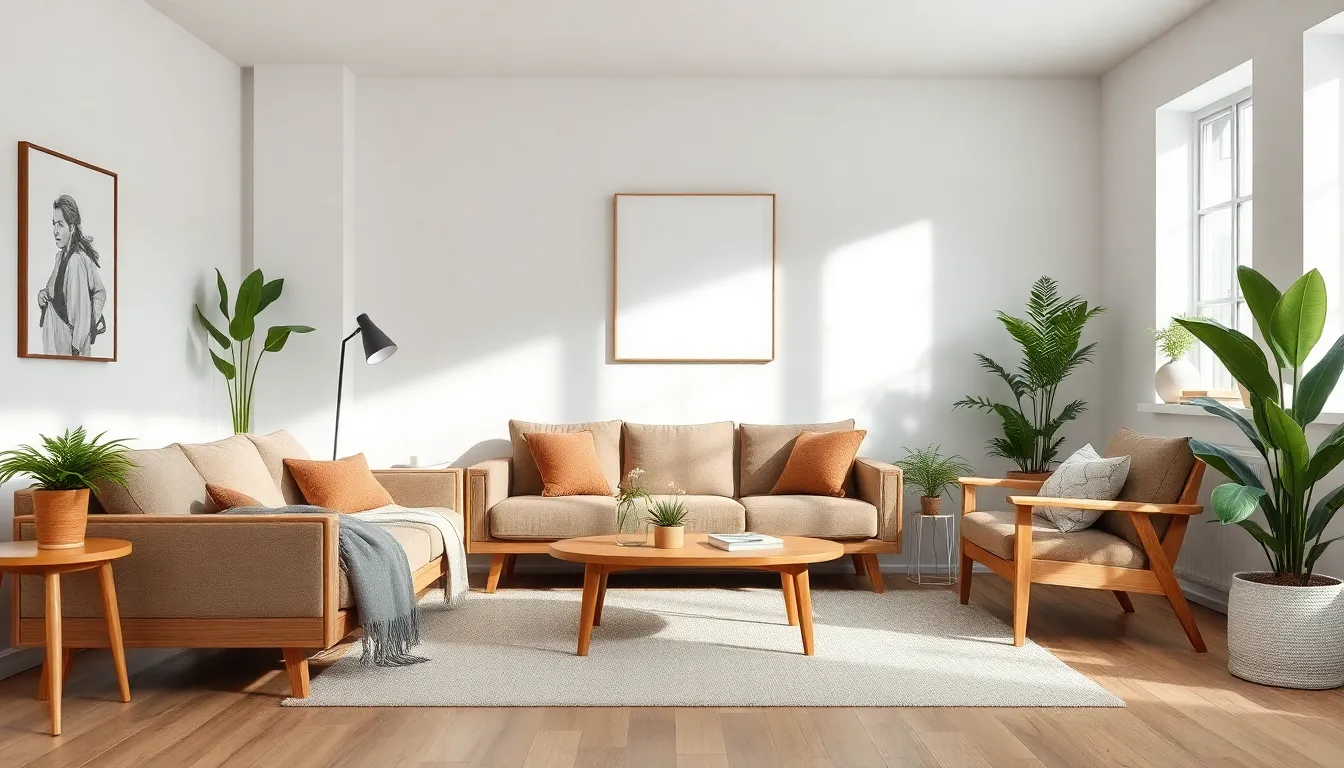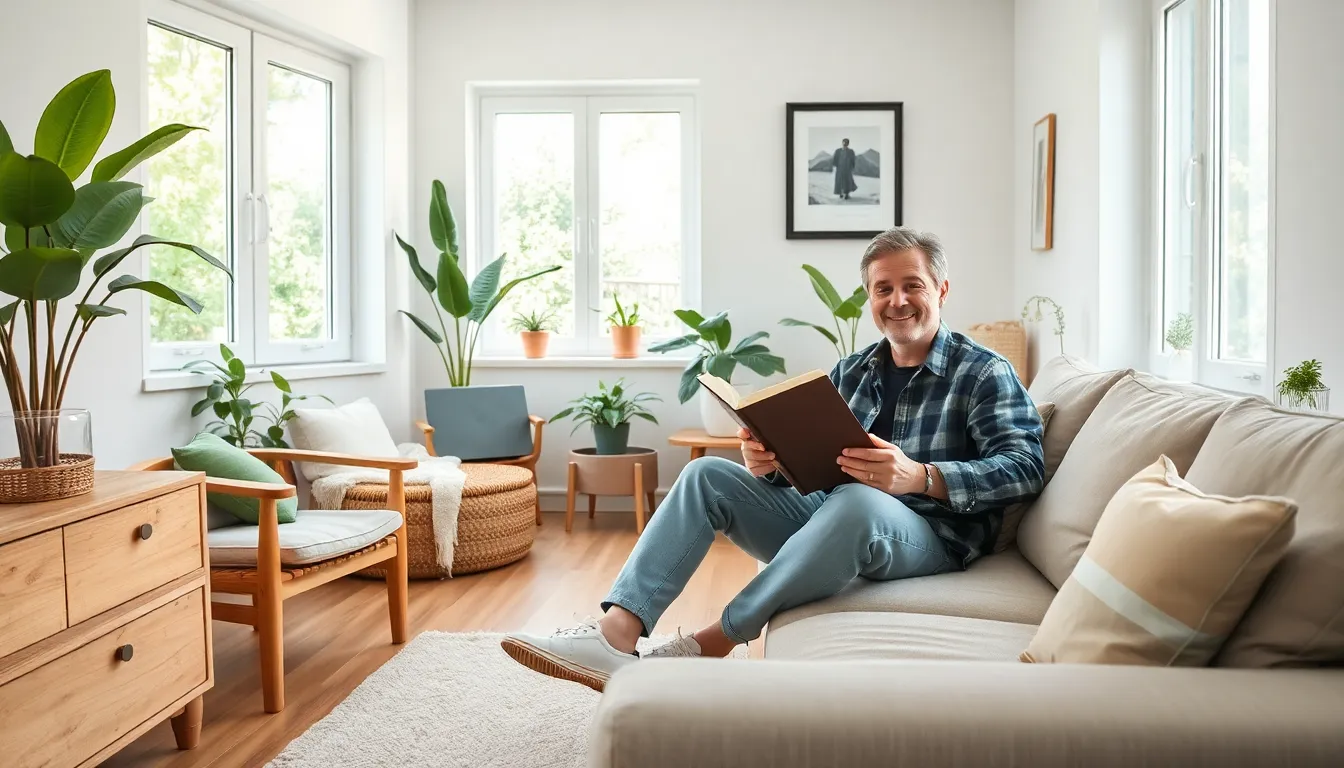Scandinavian design isn’t just a style; it’s a lifestyle that whispers elegance while shouting functionality. Imagine a world where minimalist aesthetics meet cozy warmth, all wrapped up in a sleek, modern bow. That’s what Scandinavian design brings to the table—literally and figuratively.
In 2023, these trends are more than just a passing fad; they’re a movement toward simplicity and sustainability that even your cluttered closet would appreciate. From earthy tones to multifunctional furniture, Scandinavian design proves that less really can be more. So grab your favorite cup of coffee, kick back, and let’s dive into the stylish realm of Nordic inspiration that’s taking over homes and hearts alike.
Table of Contents
ToggleOverview of Scandinavian Design Trends
Scandinavian design trends in 2023 showcase a strong emphasis on sustainability and minimalism. These principles prioritize the use of natural materials and eco-friendly practices. Earthy tones dominate, creating a calming atmosphere in living spaces. Shades of green, beige, and soft browns contribute to a serene environment that reflects nature.
Functionality remains a core aspect of this design style. Designers create multifunctional furniture to optimize space, accommodating urban living. For example, sofas that convert to beds or tables that expand provide practical solutions. This adaptability aligns with contemporary lifestyles.
Biophilic design plays a significant role in current trends as well. Incorporating plants enhances indoor spaces, promoting well-being and a connection to nature. Large windows allow natural light to fill rooms, blending the indoors with the outdoors. Light colors amplify this effect, making spaces feel airy and expansive.
Texture adds depth to Scandinavian interiors. Combining materials such as wood, metal, and textiles creates visual interest while maintaining a cohesive look. Soft, cozy textiles in rugs and cushions invite comfort, reinforcing the timeless appeal of Scandinavian aesthetics.
Artisanship is celebrated within the movement. Handmade items, including pottery or woven accessories, infuse character into spaces. Such unique pieces reflect personal style and enhance authenticity in decor.
Overall, 2023 emphasizes tranquility and practicality in Scandinavian design trends. Those seeking to create harmonious environments find inspiration in these evolving ideals that marry beauty with functionality.
Key Characteristics of Scandinavian Design

Scandinavian design features a blend of simplicity, functionality, and a commitment to sustainability. Its unique traits create a harmonious environment.
Minimalism
Minimalism serves as the foundation of Scandinavian design. Clean lines and open spaces characterize this aesthetic, allowing light to flow freely. Furnishings embrace a less-is-more philosophy, eliminating excess to highlight essential elements. Simplicity in decoration fosters calm and tranquility, ideal for modern living. This approach encourages mindfulness, as fewer items lead to less clutter and distraction. It helps create a serene atmosphere where each piece plays a significant role.
Functionality
Functionality remains paramount in Scandinavian design. Designers prioritize usability, ensuring each piece serves a purpose without sacrificing aesthetics. Versatile arrangements cater to small spaces, making multifunctional furniture crucial for urban living. Sofas that transform into beds and tables with built-in storage exemplify this trend. Smart design integrates technology seamlessly, enhancing everyday life. Spaces are carefully designed to address needs, reflecting an understanding of modern lifestyles.
Natural Materials
Natural materials take center stage in Scandinavian design. Wood, stone, and textiles evoke warmth and comfort while promoting sustainability. Designers favor materials with minimal processing, preserving their organic beauty. Earthy tones enhance the connection to nature, creating a calming atmosphere indoors. Combining different textures adds depth to designs while maintaining a cohesive look. By celebrating craftsmanship, handmade items infuse character and authenticity into interiors. Incorporating plants further enriches these spaces, enhancing well-being and fostering a biophilic connection to the outdoors.
Color Palettes in Scandinavian Design
Scandinavian design prominently features specific color palettes that enhance its characteristic simplicity and functionality. Designers often utilize these colors to create inviting and serene environments.
Neutral Shades
Neutral shades serve as the foundation of Scandinavian design. Soft whites, light grays, and warm beiges dominate interior spaces, fostering a sense of calm. These colors reflect natural light effectively, making rooms appear larger and more airy. The emphasis on neutral tones allows for versatility in decor, enabling seamless integration with various textures and materials. Additionally, these hues provide a backdrop that highlights furniture and accessories, making them focal points. By keeping the base color palette neutral, designers prioritize tranquility and sophistication, consistent with Scandinavian principles.
Bold Accents
Bold accents play a vital role in enhancing the minimalist aesthetic of Scandinavian design. Shades of deep blue, forest green, or vibrant mustard yellow add striking contrast to neutral spaces. Incorporating these colors through furniture, artwork, or textiles introduces visual interest while maintaining overall harmony. Accents draw attention to specific areas, creating focal points that energize the room. These invigorating hues also reflect personal expression, allowing homeowners to showcase individuality within a simplistic framework. Ultimately, the strategic use of bold colors contributes to a balanced and dynamic environment, aligning with contemporary Scandinavian trends.
Popular Scandinavian Design Styles
Scandinavian design features several popular styles that embody simplicity and functionality. Each style reflects the values of the Nordic lifestyle while adapting to modern preferences.
Mid-Century Modern
Mid-century modern design combines minimalism with organic forms. Inspired by the 1940s through the 1960s, it emphasizes seamless connection between interior and exterior spaces. Key elements include simple geometric shapes and furniture with clean lines that showcase craftsmanship. This style often utilizes natural materials, such as wood, to project warmth and comfort. Scandinavian designers draw from this era, creating timeless pieces that are both functional and aesthetically pleasing. Rooms featuring mid-century modern elements often include iconic furniture pieces, such as Eames chairs or Scandinavian sofas, which enhance the overall atmosphere by adding sophistication.
Contemporary Scandinavian
Contemporary Scandinavian style represents the evolution of traditional design principles. Current trends feature open floor plans and an abundance of natural light, creating airy and inviting spaces. Designers prioritize sustainable materials and eco-friendly practices, aligning with the values of modern consumers. Color palettes often include bright whites and soft pastels, providing a neutral backdrop that complements various textures. Incorporating decorative plants fosters a biophilic connection to nature, further enhancing the environment. Functionality plays a crucial role, with multipurpose furniture transforming spaces for diverse needs. This approach results in homes that balance beauty and practical living, showcasing the adaptability of Scandinavian design.
Influences on Modern Interior Design
Scandinavian design significantly influences modern interior design by prioritizing sustainability and minimalism. Incorporating natural materials like wood and stone fosters warmth and comfort in living spaces. Designers emphasize functionality through versatile furniture pieces, catering to urban lifestyles where space optimization is essential.
Biophilic elements, such as large windows and indoor plants, connect homes with nature, enhancing well-being. Trends in 2023 highlight earthy tones like soft greens, beiges, and browns to create a calming atmosphere. Such palettes reflect nature while integrating seamlessly with various textures and materials.
Texture plays a critical role, with diverse combinations enhancing depth and interest. Celebrating craftsmanship, handmade items contribute unique character to interiors, contrasting with mass-produced decor. Adopting a focus on clean lines and open spaces further cultivates serenity, aligning with minimalistic principles.
Bold accent colors, including deep blues and vibrant yellows, introduce visual energy without overwhelming the minimalist aesthetic. Reflecting personal expression, these colors breathe life into serene backdrops while maintaining harmony.
Popular styles, such as Mid-Century Modern and Contemporary Scandinavian, illustrate this evolution. Mid-Century Modern design features iconic furniture pieces and organic forms, bridging indoor and outdoor environments. Contemporary Scandinavian style emphasizes sustainable materials and spacious layouts, reflecting modern consumer values while remaining stylish.
These influences collectively enhance the appeal of Scandinavian design, inspiring individuals seeking a balance of beauty and practicality in their living spaces.
Conclusion
Scandinavian design continues to resonate in 2023 with its commitment to sustainability and minimalism. The blend of earthy tones and multifunctional furniture enhances both beauty and practicality in modern homes. By embracing natural materials and biophilic elements, this design philosophy invites a deeper connection to nature while fostering a serene atmosphere.
The celebration of craftsmanship and texture adds unique character to interiors, making them feel both authentic and inviting. As individuals seek harmony in their living spaces, Scandinavian design trends offer a timeless solution that balances elegance with functionality. This enduring style inspires a lifestyle that prioritizes well-being and thoughtful living.




